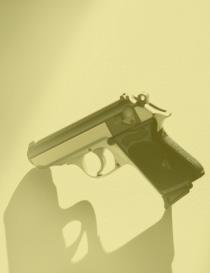Strengthening the public health debate on handguns, crime and safety
A strong body of public health research points to policy solutions that could save lives and prevent injury from guns. Yet public health advocates are not as effective as they could be in translating this research on the consequences of easy handgun availability into compelling arguments and widespread, prominent news coverage. Our objective with this project was to bring accuracy to the debate and increase the visibility of public health perspectives on handgun violence. We did this by developing strong, research-based counter-arguments to laws allowing easy handgun availability and then held a media advocacy training to equip Joyce Foundation grantees with the information and skills they need to make those arguments publicly.
Media advocacy
In order to generate raw material for public health arguments and counter arguments on challenging gun policies, we convened a day-and-a-half meeting in Chicago of the best thinkers on this issue nationwide. We invited advocates and researchers alike. We challenged the thinkers to answer succinctly the most difficult questions about gun violence prevention and distilled their remarks into a curriculum for training advocates: Making the Case on Public Health and Guns [contact us for a copy]. As background for the meeting, we commissioned three papers:
- The Gun Control Movement Has Found its Voice, But Still Needs to Find Its Way, (a review of public opinion research on gun policies), by Ethel Klein of EDK Associates
- Myths about Defensive Gun Use and Permissive Gun Carry Laws by Daniel Webster of Johns Hopkins University and Jens Ludwig of Georgetown University
- Gun Policy in Seven Midwestern States: A Brief Analysis by Eric Gorovitz and Vincent Ferri of The Bell Campaign
Training
Using the curriculum developed after the meeting, we offered an intensive media advocacy training to selected Joyce Foundation grantees working on firearms policy to prepare grantees to counter arguments on the “benefits” of handgun ownership, pitch public-health-oriented stories to journalists, design and participate in news events, use editorial strategies, and be confident spokespeople.
Framing memo
Prior to developing the curriculum, we analyzed newspaper coverage of gun policy debates (including the major Midwest newspapers as well as national sources), from March 1 through May 31, 1999. This analysis, The Debate on Gun Policies in U.S. and Midwest Newspapers, shows the enormous agenda-setting power of an event like the Columbine shootings; in our sample, 15 pieces on gun policies were published in the six weeks prior to Columbine, while 155 appeared in the six weeks after. The tragedy at Columbine got America talking about what to do about guns in a new way. But in the newspapers, it is still mostly politicians doing the talking, often using gun policy debates to fuel their political blame games. This shows the need for advocates to take more initiative in injecting public health arguments into the public debate on guns, crime, and safety.
Journalist education
In the final phase of the project, we developing a mini-handbook for reporters on emerging gun issues, complete with facts and expert sources on ballistic fingerprinting, .50 caliber bullets, assault weapons, sniper rifles, personalized handguns and the law in New Jersey, licensing and registration, the Second Amendment, and the health benefits of banning Saturday night specials.




